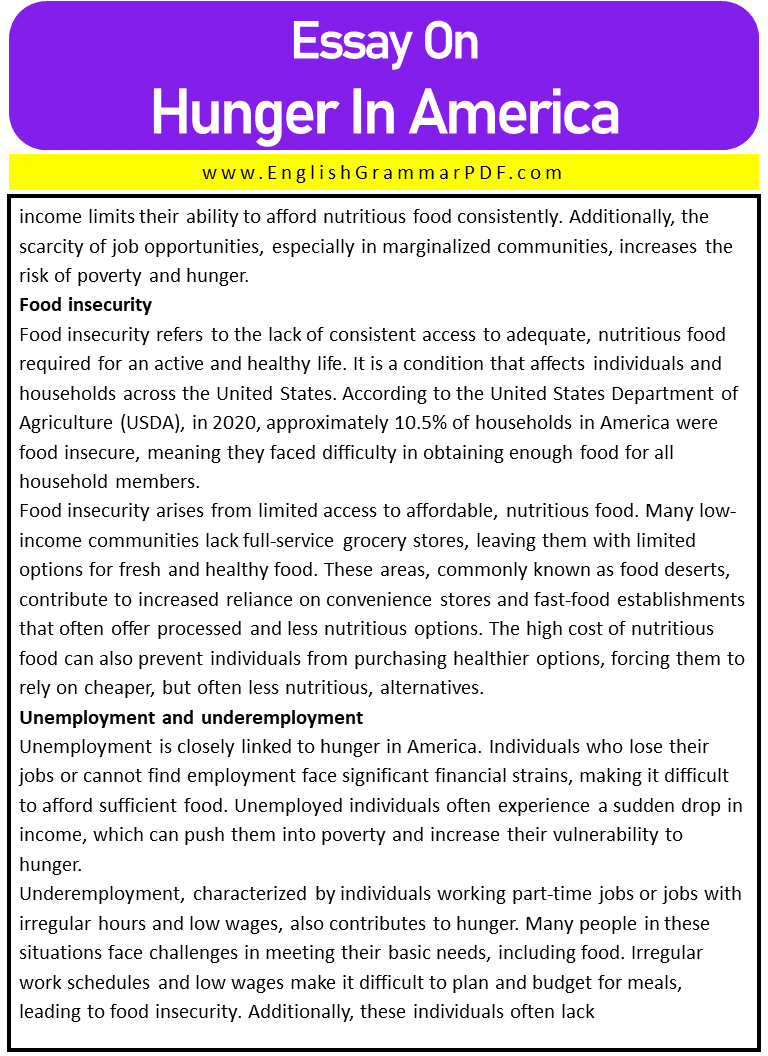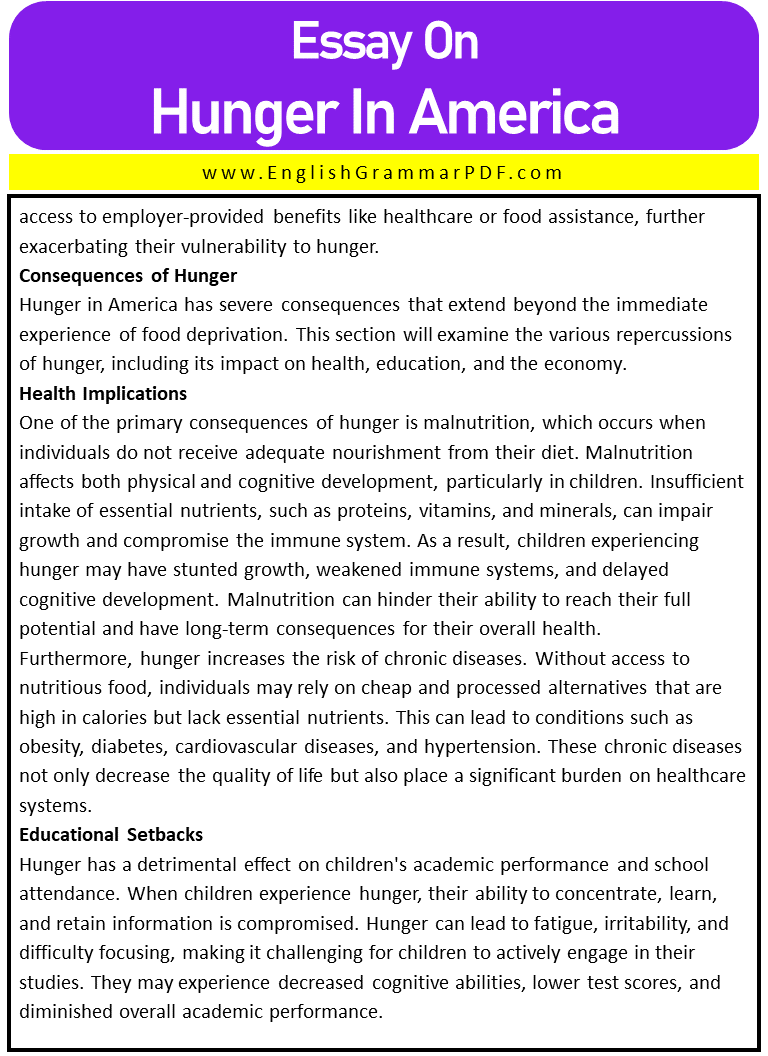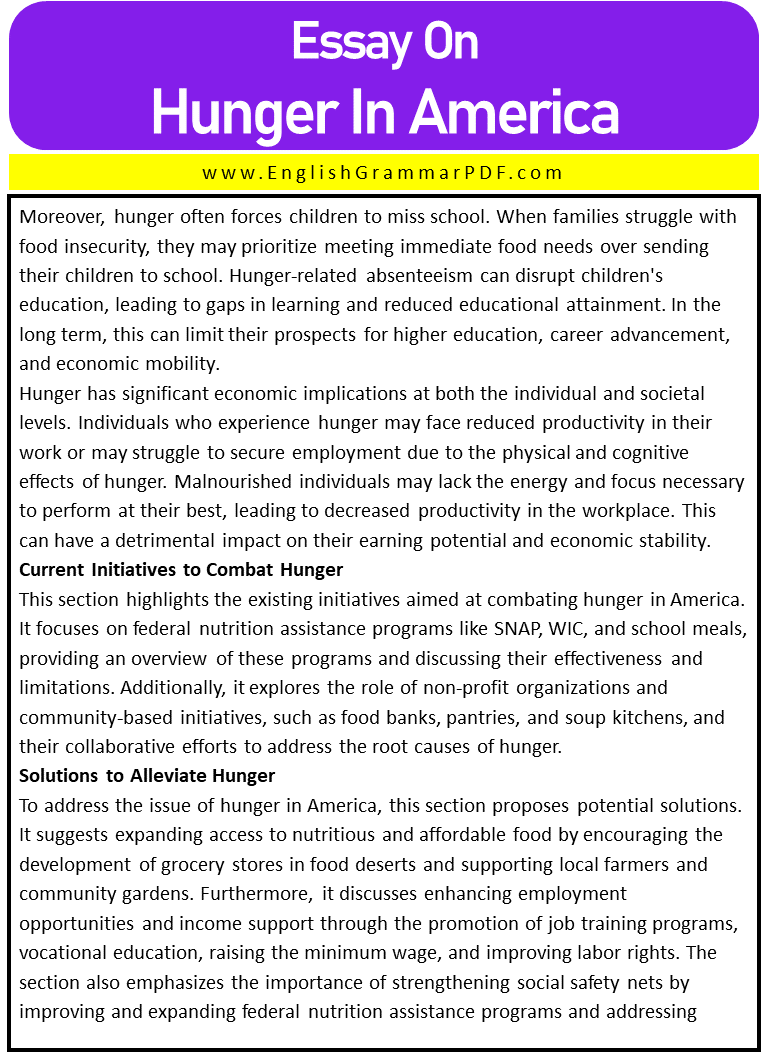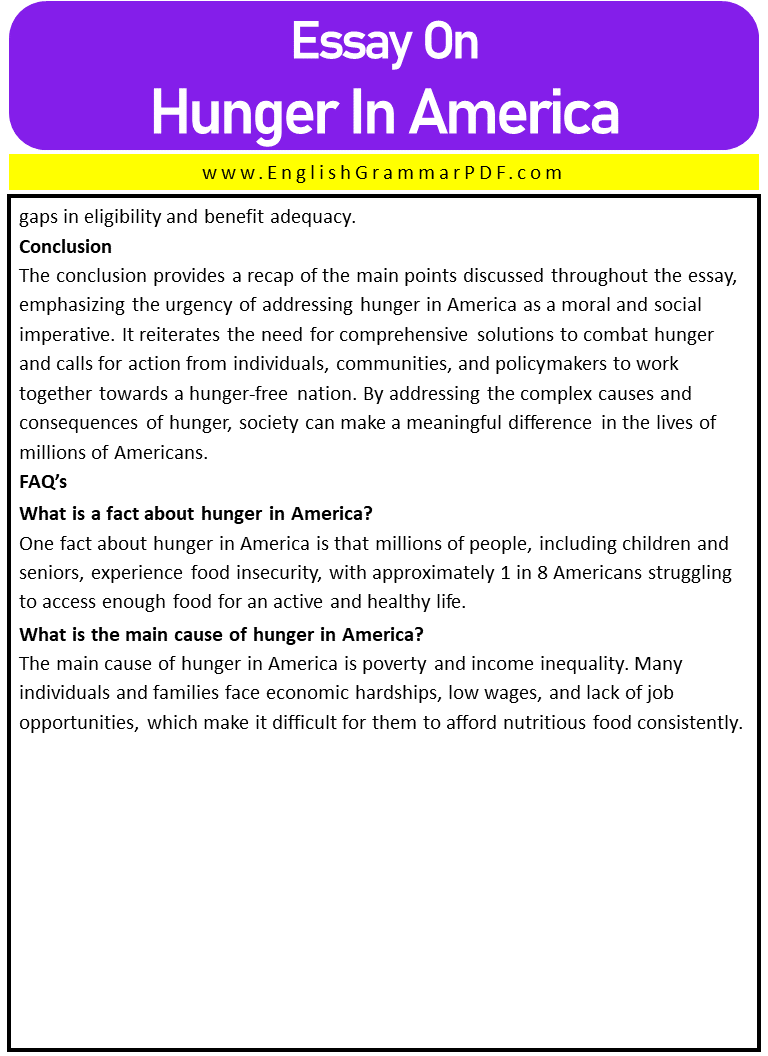Essay On Hunger In America
Outline of Essay:
- Introduction
- Causes of Hunger in America
- Consequences of Hunger
- Current Initiatives to Combat Hunger
- Solutions to Alleviate Hunger
Introduction
Hunger in America is a pressing social issue that affects millions of people and requires immediate attention. The introduction provides a brief overview of the problem and highlights its importance as a critical social problem. It concludes with a thesis statement stating that hunger in America is a complex issue with various causes and consequences, and it necessitates comprehensive solutions to alleviate the suffering of millions.
Causes of Hunger in America
Hunger in America is a complex issue with multiple underlying causes. Understanding these causes is crucial for developing effective strategies to combat and alleviate hunger. This section explores three significant factors contributing to hunger in America: poverty and income inequality, food insecurity, and unemployment and underemployment.
Poverty and income inequality
Poverty rates in the United States provide insight into the scale of the problem. According to the U.S. Census Bureau, in 2020, the official poverty rate was 11.4%, which equates to approximately 37 million people living below the poverty line. These numbers demonstrate the significant proportion of the population struggling with poverty-related challenges, including hunger.
Low wages and a lack of job opportunities exacerbate hunger in America. Many individuals working full-time jobs, particularly in low-wage sectors such as retail, food service, and agriculture, still struggle to make ends meet. Insufficient income limits their ability to afford nutritious food consistently. Additionally, the scarcity of job opportunities, especially in marginalized communities, increases the risk of poverty and hunger.
Food insecurity
Food insecurity refers to the lack of consistent access to adequate, nutritious food required for an active and healthy life. It is a condition that affects individuals and households across the United States. According to the United States Department of Agriculture (USDA), in 2020, approximately 10.5% of households in America were food insecure, meaning they faced difficulty in obtaining enough food for all household members.
Food insecurity arises from limited access to affordable, nutritious food. Many low-income communities lack full-service grocery stores, leaving them with limited options for fresh and healthy food. These areas, commonly known as food deserts, contribute to increased reliance on convenience stores and fast-food establishments that often offer processed and less nutritious options. The high cost of nutritious food can also prevent individuals from purchasing healthier options, forcing them to rely on cheaper, but often less nutritious, alternatives.
Unemployment and underemployment
Unemployment is closely linked to hunger in America. Individuals who lose their jobs or cannot find employment face significant financial strains, making it difficult to afford sufficient food. Unemployed individuals often experience a sudden drop in income, which can push them into poverty and increase their vulnerability to hunger.
Underemployment, characterized by individuals working part-time jobs or jobs with irregular hours and low wages, also contributes to hunger. Many people in these situations face challenges in meeting their basic needs, including food. Irregular work schedules and low wages make it difficult to plan and budget for meals, leading to food insecurity. Additionally, these individuals often lack access to employer-provided benefits like healthcare or food assistance, further exacerbating their vulnerability to hunger.
Consequences of Hunger
Hunger in America has severe consequences that extend beyond the immediate experience of food deprivation. This section will examine the various repercussions of hunger, including its impact on health, education, and the economy.
Health Implications
One of the primary consequences of hunger is malnutrition, which occurs when individuals do not receive adequate nourishment from their diet. Malnutrition affects both physical and cognitive development, particularly in children. Insufficient intake of essential nutrients, such as proteins, vitamins, and minerals, can impair growth and compromise the immune system. As a result, children experiencing hunger may have stunted growth, weakened immune systems, and delayed cognitive development. Malnutrition can hinder their ability to reach their full potential and have long-term consequences for their overall health.
Furthermore, hunger increases the risk of chronic diseases. Without access to nutritious food, individuals may rely on cheap and processed alternatives that are high in calories but lack essential nutrients. This can lead to conditions such as obesity, diabetes, cardiovascular diseases, and hypertension. These chronic diseases not only decrease the quality of life but also place a significant burden on healthcare systems.
Educational Setbacks
Hunger has a detrimental effect on children’s academic performance and school attendance. When children experience hunger, their ability to concentrate, learn, and retain information is compromised. Hunger can lead to fatigue, irritability, and difficulty focusing, making it challenging for children to actively engage in their studies. They may experience decreased cognitive abilities, lower test scores, and diminished overall academic performance.
Moreover, hunger often forces children to miss school. When families struggle with food insecurity, they may prioritize meeting immediate food needs over sending their children to school. Hunger-related absenteeism can disrupt children’s education, leading to gaps in learning and reduced educational attainment. In the long term, this can limit their prospects for higher education, career advancement, and economic mobility.
Hunger has significant economic implications at both the individual and societal levels. Individuals who experience hunger may face reduced productivity in their work or may struggle to secure employment due to the physical and cognitive effects of hunger. Malnourished individuals may lack the energy and focus necessary to perform at their best, leading to decreased productivity in the workplace. This can have a detrimental impact on their earning potential and economic stability.
Current Initiatives to Combat Hunger
This section highlights the existing initiatives aimed at combating hunger in America. It focuses on federal nutrition assistance programs like SNAP, WIC, and school meals, providing an overview of these programs and discussing their effectiveness and limitations. Additionally, it explores the role of non-profit organizations and community-based initiatives, such as food banks, pantries, and soup kitchens, and their collaborative efforts to address the root causes of hunger.
Solutions to Alleviate Hunger
To address the issue of hunger in America, this section proposes potential solutions. It suggests expanding access to nutritious and affordable food by encouraging the development of grocery stores in food deserts and supporting local farmers and community gardens. Furthermore, it discusses enhancing employment opportunities and income support through the promotion of job training programs, vocational education, raising the minimum wage, and improving labor rights. The section also emphasizes the importance of strengthening social safety nets by improving and expanding federal nutrition assistance programs and addressing gaps in eligibility and benefit adequacy.
Conclusion
The conclusion provides a recap of the main points discussed throughout the essay, emphasizing the urgency of addressing hunger in America as a moral and social imperative. It reiterates the need for comprehensive solutions to combat hunger and calls for action from individuals, communities, and policymakers to work together towards a hunger-free nation. By addressing the complex causes and consequences of hunger, society can make a meaningful difference in the lives of millions of Americans.
FAQ’s
What is a fact about hunger in America?
One fact about hunger in America is that millions of people, including children and seniors, experience food insecurity, with approximately 1 in 8 Americans struggling to access enough food for an active and healthy life.
What is the main cause of hunger in America?
The main cause of hunger in America is poverty and income inequality. Many individuals and families face economic hardships, low wages, and lack of job opportunities, which make it difficult for them to afford nutritious food consistently.
Explore More Essays:
Download the PDF of Essay








